The Elder Scrolls Online hands-on: first-person mode, skills, stealth and more
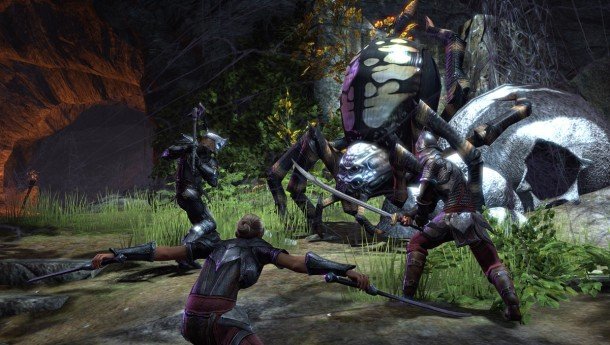
At a press event at Zenimax Online Studios last week, the Elder Scrolls Online developer waited until the end of a lengthy presentation to deliver arguably the most important piece of news about their upcoming MMO. In short: TESO will have a full first-person mode in the Elder Scrolls style. This is, I suspect, what the majority of fans have been waiting to hear. It should certainly delay the inevitable “meh” in the comments below, if such a thing is possible.
First person wasn't available in the build I played - we were shown it in a video, but it looks great. The constraints of MMO development mean that The Elder Scrolls Online isn't as technically impressive as Skyrim, but this was the moment when the penny dropped for me. Having powered through two and a bit zones' worth of content - the first six levels of the game, playing as the Daggerfall Covenant faction - there's much that makes TESO distinct and interesting as an MMO: but proper first person play is the thing.
T.J. will be writing about his experience of the game from the perspective of a longstanding Elder Scrolls fan later on today: in this article, I'm going to cover the new information that came to light in my three hours with the game. Up front, though, I will say this: I went in worried and came out pretty pleased. There are new ideas here. I don't believe that there's a single type of person defined by the phrase 'Elder Scrolls fan' and I can see it working for some but not others. If your time in Skyrim was exclusively spent tooling around with emergent systems, murdering townspeople in their beds and stacking cheese wheels, then you'll feel the absence of those things from TESO. If you're up for something a bit more structured, then keep it on your radar.
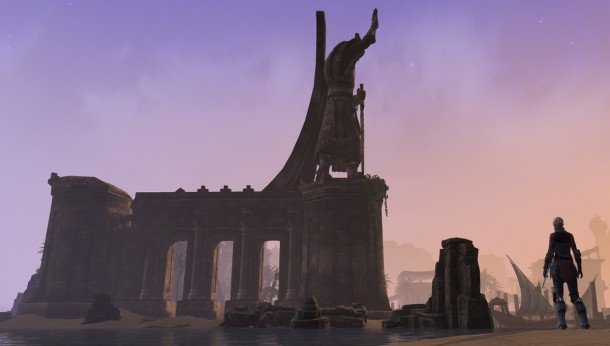
The UI is among the most minimalistic I've seen in an MMO. The only persistent on-screen items are a crosshair, a minimap, and a small quest tracker. Health, stamina and magicka bars along with the hotbar appear during combat or when you're wounded, but otherwise the focus is on the world. There are no damage numbers or debuff indicators for enemies beyond what is visibly happening to them. At present, the game could do with better feedback - I can get behind the idea of toning down typical MMO on-hit fireworks, but they need to be replaced with something and at the moment it's not quite there.
Dialogue takes place in a zoomed-in first person similar to Skyrim, with a slightly expanded dialogue menu that more closely resembles Morrowind. It's all fully voiced, but facial animation is a bit rough at the moment.
The inventory and skill menus follow Skyrim's trend toward representing as much in-world as possible. Bringing either of these up zooms the camera in on your character in the world, who then effectively acts as your paper doll for equipping items.
Combat, while not as impactful as Skyrim, is not based on MMO-style rotations. As in any of the post-Morrowind TES games, you swing your weapon (or fire your bow or staff) with the left mouse button and block with the right. Holding attack charges up a powerful strike, and attacking while blocking results in a spell-interrupting bash. If you manage to block an enemy's telegraphed power attack you'll stun them, and your subsequent blows do more damage.
The biggest gaming news, reviews and hardware deals
Keep up to date with the most important stories and the best deals, as picked by the PC Gamer team.
The hotbar includes six slots for abilities plus an additional ultimate skill - I didn't get to use these, but one example would be a Meteor spell - and a consumable. Its resemblance to a traditional MMO quickbar is deceptive, because skills in TESO are not cooldown based. Your ability to spam skills is entirely based on your available health, stamina or magicka, and as such combat is more about effective use of those resources than it is about settling into a set rhythm. Blocking, sprinting and dodging use stamina, for example, making them a trade-off with powerful melee skills like cleaves.
Unlike prior Elder Scrolls games, spells do not need to be equipped into a hand before being cast - they fire instantly. This speeds up combat and is the chief thing - besides the aforementioned feedback issues - that makes TESO feel different to previous games in the series. Expect to see more spells being cast, by more people. Nonetheless, the system is theoretically closer to the single player games than it is to most MMOs.
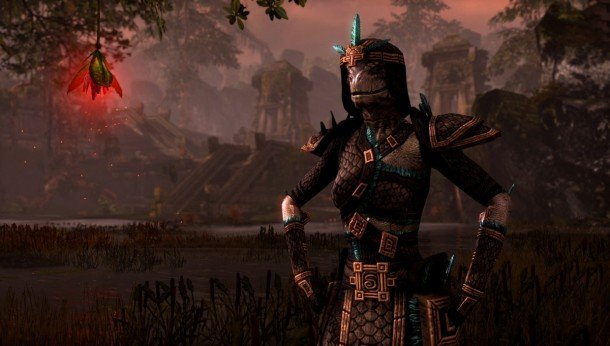
Stealth is available to everyone, but it isn't as deep as Skyrim. Press control to crouch and you enter sneak mode, which allows you to bypass camps of enemies and complete quests without violence if you're good at it. It's based on line of sight rather than dynamic light levels, so sneaking about requires a bit of planning. Sneaking replaces your cursor with a Skyrim-style eye to let you know when you're liable to be detected.
It's also possible to loot disguises from select enemies or find them in camps. Wearing a disguise allows you to move around normally in hostile areas, but getting to close to an alert enemy can break your cover.
The skill system sits somewhere between Skyrim and Guild Wars 2, with select improvements over both. As in Skyrim, levelling up in TESO earns you a boost to either health, stamina or magicka and a skill point to spend. You start the game with a selection of skill lines based on your class, race, and equipment. Examples from the weapons group would be:
- Two Handed
- One Hand and Shield
- Dual wield
- Bow
- Destruction Staff
- Restoration Staff
Investing points in each skill line unlocks new passive and active skills. Active skills level up through use, and at rank five you can spend another skill point to 'morph' these spells and abilities into one of two variants. An example we were shown was a Daedric summoning skill that could be altered to conjure either an exploding scamp or a hulking clannfear.
Although there will be a finite amount of skill points available to a single character, more skill lines can be acquired over time. Members of the Fighters' and Mages' Guilds, for example, get access to new skills based on their rank in those factions. There are special abilities for PvP, and this is also how special player states like vampirism will be handled. The system is impressive precisely because it's so expandable: its easy to see how new skill lines can add options to the game without imbalancing it in the way that an extended level cap or tacked-on alternate advancement system might.
The Fighters' and Mages' Guilds will be in at launch, with thieves and the Dark Brotherhood to be added later. Fighter's Guild members will be tasked with hunting Daedra and banishing Molag Bal's Dark Anchors from the surface of Tamriel. Mages are tasked with tracking down necromantic lore.
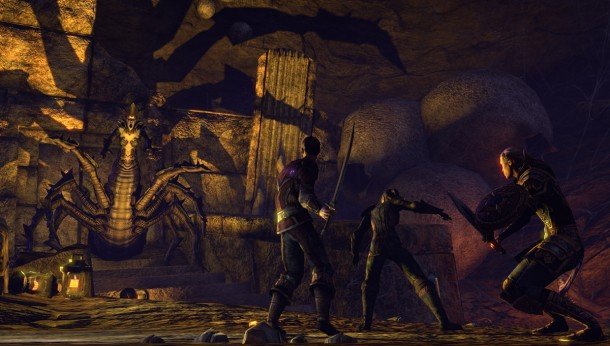
Towns are relatively static, but enemy combat AI has been reworked. NPCs in TESO live deterministic lives based on your actions: they do move about, but this is phased as part of your progress within the various questlines. In combat, however, things are more flexible. Enemies will interact with one another based on their type - for example, multiple humanoid foes will work together, calling for healing or special attacks as the situation demands. Then, enemies who all belong to the same faction will have access to additional powers. The example we were shown was a group of necromancers - a warrior and two mages of different schools - dynamically starting a sacrificial summoning ritual to hold off the player party.
Monsters also have special abilities. Spriggans will possess and enhance any woodland predators that stray nearby, and spiders will eat their slain allies to gain strength. Lovely.
Quests are very subtly instanced. Its surprising to be playing an MMO and find a quest giver jogging alongside you once you've picked up their quest - or to emerge from a dungeon only to have the person you're helping run over to give you your reward straight away. This is thanks to a phasing implementation that is almost seamless. A major part of every personal story will be assembling a group of heroes, and these allies are not only consistent across zones but appear in the open world rather than in specific story instances. Other players' companions are rendered as anonymous mercenaries, preserving your immersion in a way that evades TOR-style companion clone syndrome.
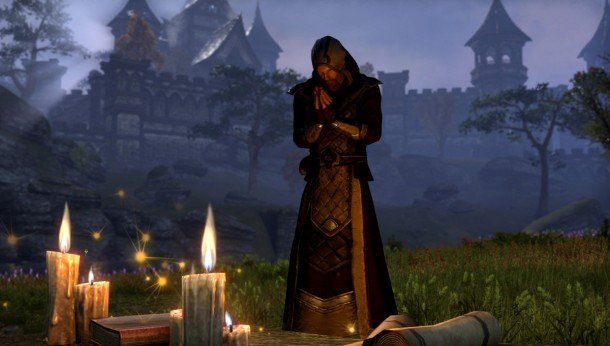
It looks like an Elder Scrolls game, but it has been designed as an MMO.
An evident effort has been made to match up TESO to the art style and geography established by the previous games, but interiors and doorways have been enlarged to accommodate more players. We were told that the height maps from Oblivion and Skyrim have informed the layout of the relevant zones. In a neat touch, the fortresses that you'll fight over in PvP are based on the ruins from Oblivion, including their name and approximate locations.
You can play through every zone on a single character, regardless of faction. There's a reason why few MMOs bother with three factions nowadays - it's a vast amount of content to create, particularly when you're only likely to see a third of it. TESO's solution is clever. You'll level from 1-50 and do your personal story with your chosen faction, then when you're finished you can pick a second faction to play through in what amounts to a new game plus. Zones and encounters are buffed to 50 and loot updated accordingly. Then, when you finish that you'll be able to play through the final faction in an even tougher mode. You'll still only be able to group and socialise with members of your own faction, but it means you don't have to pick what race you play based solely on what zones you want to adventure in. Your Breton will get to wander around Skyrim.
Crafting adopts a lot of what was good about Skyrim's alchemy and applies it to the whole system. There are five professions: Armorsmith, Weaponsmith, Enchanter, Alchemist and Provisioner (cook). One player will be able to dabble in all five, but only one can be fully mastered. Items are made from a set of base ingredients and then a selection of bonus additives which all have hidden properties similar to alchemical ingredients in prior TES games. Reverse-engineering looted items will allow you to determine some of these properties, which can then be applied to your own items. In addition, you also pick a style for wearable items like weapons and armour: an iron axe could be orcish, Breton, aldmeri etc. We watched one of the game's designers invest heavily in crafting a Fine Iron Battle Axe of Undead Bane of Lightning. I understand they're working on the name.
The Elder Scrolls Online will be playable on the floor at PAX East this week and is in closed beta now. We'll have a video interview with two of the game's senior designers going up at 3pm GMT, with T.J.'s take to follow at 4pm.
Joining in 2011, Chris made his start with PC Gamer turning beautiful trees into magazines, first as a writer and later as deputy editor. Once PCG's reluctant MMO champion , his discovery of Dota 2 in 2012 led him to much darker, stranger places. In 2015, Chris became the editor of PC Gamer Pro, overseeing our online coverage of competitive gaming and esports. He left in 2017, and can be now found making games and recording the Crate & Crowbar podcast.


